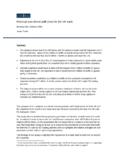Transcription of Human failure types - Health and Safety Executive
1 Human failure types Human failure Human failure ErrorErrorNon-ComplianceNon-ComplianceAc tion ErrorAction ErrorThinking ErrorThinking ErrorAction-BasedAction-BasedSlipSlipMem ory-BasedMemory-BasedLapseLapseRule-Base dRule-BasedMistakeMistakeKnowledge-Based Knowledge-BasedMistakeMistakeRoutineRout ineSituationalSituationalExceptionalExce ptional Remember to optimise PIFsRemember to optimise PIFsPerformance Influencing Factors (PIFs) are the characteristics of the job, the individual and the organisation that influence Human performance. Optimising PIFs will reduce the likelihood of all types of Human failure TypesCharacteristicsFailure TypeExamplesTypical Control MeasuresAction ErrorsAssociated with familiar tasks that require little conscious attention.
2 These skill-based errors occur if attention is diverted, even action is not intended: not doing what you meant to do .Common during maintenance and repair (Commission)A simple, frequently-performed physical action goes wrong: flash headlights instead of operating windscreen wash/wipe function move a switch up rather than down (wrong action on right object) take reading from wrong instrument (right action on wrong object) transpose digits during data input into a process control interface Human -centred design (consistency up always means off; intuitive layout of controls and instrumentation; level of automation etc.) checklists and reminders; procedures with place markers (tick off each step) independent cross-check of critical tasks (PTW) removal of distractions and interruptions sufficient time available to complete task warnings and alarms to help detect errors often made by experienced, highly-trained, well-motivated staff: additional training not validLapse(Omission)Short-term memory lapse.
3 Omit to perform a required action: forget to indicate at a road junction medical implement left in patient after surgery miss crucial step, or lose place, in a Safety -critical procedure drive road tanker off before delivery complete (hose still connected)Thinking ErrorsDecision-making failures; errors of judgement (involve mental processes linked to planning; info. gathering; communication etc.)Action is carried out, as planned, using conscious thought processes, but wrong course of action is taken: do the wrong thing believing it to be right Rule-BasedMistakeIf behaviour is based on remembered rules and procedures, mistake occurs due to mis-application of a good rule or application of a bad rule.
4 Misjudge overtaking manoeuvre in unfamiliar, under-powered car assume 20 fuel will last a week but fail to account for rising prices ignore alarm in real emergency, following history of spurious alarms plan for all relevant what ifs (procedures for upset, abnormal and emergency scenarios) regular drills/exercises for upsets/emergencies clear overview / mental model (clear displays; system feedback; effective shift handover etc.) diagnostic tools and decision-making aids (flow-charts; schematics; job-aids etc.) competence (knowledge and understanding of system; training in decision-making techniques) organisational learning (capture and share experience of unusual events)Knowledge-BasedMistakeIndividual has no rules or routines available to handle an unusual situation: resorts to first principles and experience to solve problem: rely on out-of-date map to plan unfamiliar route misdiagnose process upset and take inappropriate corrective action (due to lack of experience or insufficient / incorrect information etc.)
5 Non ComplianceDeliberate deviations from rules, procedures, regulations etc. Also known as violations Knowingly take short cuts, or fail to follow procedures, to save time or well-meaning, but misguided (often exacerbated by unwitting encouragement from management for getting the job done ).RoutineNon-compliance becomes the norm ; general consensus that rules no longer apply; characterised by a lack of meaningful enforcement: high proportion of motorists drive at 80mph on the motorway PTWs routinely authorised without physical, on-plant checks improve risk perception; promote understanding and raise awareness of whys & consequences ( warnings embedded within procedures) increase likelihood of getting caught effective supervision eliminate reasons to cut corners (poor job design; inconvenient requirements; unnecessary rules; unrealistic workload and targets; unrealistic procedures.)
6 Adverse environmental factors) improve attitudes / organisational culture (active workforce involvement; encourage reporting of violations; make non-compliance socially unacceptable drink-driving).SituationalNon-compliance dictated by situation-specific factors (time pressure; workload; unsuitable tools & equipment; weather); non-compliance may be the only solution to an impossible task: van driver has no option but to speed to complete day s deliveriesExceptionalPerson attempts to solve problem in highly unusual circumstances (often if something has gone wrong); takes a calculated risk in breaking rules: after a puncture, speed excessively to ensure not late for meeting delay ESD during emergency to prevent loss of production

















